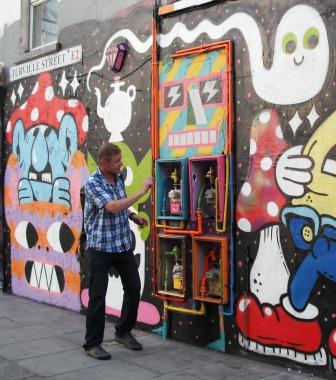
Because parts of my novel are set in Shoreditch, I was really looking forward to the Love Art London Shoreditch Graffiti Tour which was held way back at the end of May but which I’ve only just got round to blogging about for various reasons, including the interminable process of editing the novel, but hopefully the photos at least will be worth the wait.
The Shoreditch Graffiti Tour definitely didn’t disappoint. During the event I realised that I’d found exactly what I’d been looking for — and all the better for, perhaps, not having fully understood beforehand what I needed.
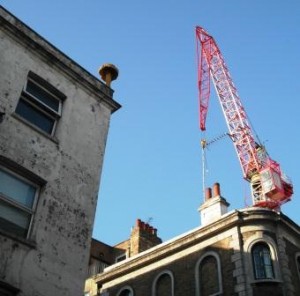
There was a good turnout for the tour, which for reasons detailed below, might better have been billed as The Shoreditch Not Graffiti Tour. At least twenty of us met Lindsay from Love Art London outside the new Shoreditch High Street Overground station on one of the last decent days of weather we’ve had this year. Cameras and phones at the ready, we were then taken on what was very like an urban safari (we had the weather for it) by our very knowledgeable guides, Sabina Andron and Jamie Ryle.
Sabina and Jamie organise a Meetup Group — I Know What I Like — which is a community of people interested in contemporary urban art — both viewing the artwork and also debating its merits.
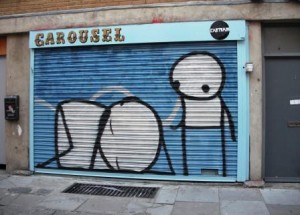
Our guides led us across Bethnal Green Roadand into the area east of Shoreditch High Street centred on extraordinary Redchurch Street (the street where the Catlin Prize exhibition was held — see later photo of the building).
This street, running parallel toBethnal Green Road, and the adjoining side streets, such as Chance Street,Ebor Street andTurville Street currently act as a huge ad hoc art gallery. It’s an incredibly concentrated area of street art where our group of intrigued observers only had to move on a few yards before being shown another significant piece of work created on a wall, door or hoarding. (This Redchurch Street locality has been designated a conservation area by Tower Hamlets council, as an example of nineteenth-century urban architecture that has largely disappeared.)
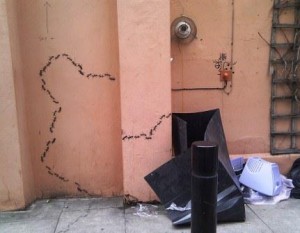
Sometimes these were very difficult to spot — small pieces no more than knee high whereas others were huge murals covering a whole block or were artworks placed high above the road (in the case of the mushroom placed on a rooftop).
Sabina and Jamie’s favourite street at the time was Blackall Street on the west side of Shoreditch, past Village Underground. This was temporarily unique because building work had blocked off the Paul Street end of the road, which meant there was very little traffic to disturb the artists and so had become a favoured place for the time being where they could work relatively undisturbed.
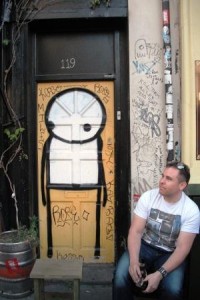
I won’t try to comment on the artworks or the artists themselves — Sabina and Jamie told us some fascinating stories and anecdotes about the works and were able to provide comment on some very recent developments. I’d certainly recommend them as expert guides for anyone who might be interested in street art.
There are also websites such as Londonist that have street art sections (here’s Londonist’s Top 5 locations).
I’ve added several photos alongside the post which illustrate the type of art we saw on the tour. They include work by well-known artists such as Roa (who’s well known for his large monochrome animals), Ben Eine (lettering and typography), Cartrain (stencils and old vinyl records attached to buildings) and Stik (the eponymous stick men whose simple faces convey amazing expressions — and probably my favourites overall).
What surprised me overall was how these artists operated in the margins between criminality and the conventional art world — and also the community spirit of the artists, revealing a well-defined hierarchy and pecking order.
Many of the works we saw were commissioned or at least permitted by the building owners (although not always meeting the approval of the local council as a contentious case with a Roa mural of a crane in Brick Lane and Tower Hamlets council).  This explains why many of the works endure so long — as does the sense of community between the artists which means that they tend to earn respect with each other by repairing each others’ work when it’s inevitably defaced by the taggers (the lowest of the graffiti food chain).
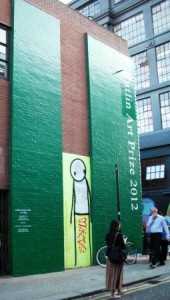
The more accomplished and innovative artists are popular with developers, who have realised that well-executed street art attracts the type of young, professional occupants that they chase for both their commercial and residential premises. However, while sanctioned street art communicates a sense of order that might re-assure, it treads a fine line between its non-permissive origins and becoming an adjunct to the corporatism that has created ‘Avant Garde Tower’ – a large block of mainly private residential flats under construction on Bethnal Green Road marketed with a huge rooftop banner bearing the slogan ‘the coolest residential tower in Shoreditch’.
Street art in this context definitely isn’t mere graffiti: the City types to whom the developers are appealing will enjoy spotting work by Roa and Eine on their way to designer bars but will be unsettled by the tags that are reminders that Tower Hamlets (which covers Shoreditch east of Boundary Road) is still one of the most deprived boroughs in the country.
In fact, while the area around Shoreditch High Street station is becoming rapidly gentrified (as is the stretch of Great Eastern Street leading towards Old Street with its Pizza Express and Prêt à Manger) Redchurch Street itself remains defiantly shabby – with many buildings either abandoned or in poor state of repair – and it is home to a very eclectic selection of shops and bars (see the photo of the Sick clothes shop).
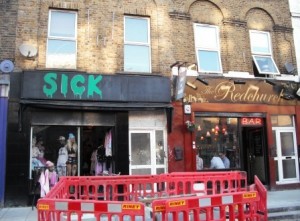
My favourite, which I didn’t photograph, is a shop (possibly Speedie’s) with a window full of technologically prehistoric TVs and video equipment from the 70s and 80s.
It shouldn’t be news to anyone that ‘street art’ has now crossed-over into the commercial arts world. David Cameron presented Barack Obama with a Ben Eine work and one of the best episodes of The Apprentice in the most recent series had the would-be apprentices trying to represent some well-known Shoreditch street artists. However, I didn’t realise quite how intertwined the commercial galleries were with street art.
It’s quite common for artists to pursue a two-pronged strategy — advertising their work by putting it on a prominent site in the likes of Redchurch Street but also making it available to purchase in galleries. Consequently, some of the artists make a more than respectable income from their commercial work.
Because some of the artwork is on surfaces that the artist doesn’t have permission to use, many artists use techniques like stencilling and pasting an already created paper-based work. Stencils are quick to use but I thought that pasting something on a wall was more like fly-posting than artwork. It’s an interesting question about the nature of this sort of art — does it matter that it’s created at the place where it’s displayed? This definitely isn’t the case for other forms of painting — a framed painting advertises that it can be hung anywhere. But street art almost by definition seems to need an association with a sense of place.
The tour made me realise that Kim, in my novel, would certainly be extremely familiar with the street art we saw, especially as her studio is at Village Underground, which has three huge walls dedicated to permissive street art. If she’s trying to promote herself as an artist, it’s quite likely that she’d try street art herself — although I can’t remember any of the artists mentioned in our tour being women. (The obvious dangers involved in solitary late-night work on dimly-lit city streets and the likes of railway sidings have historically deterred women from becoming significant members of this community.)
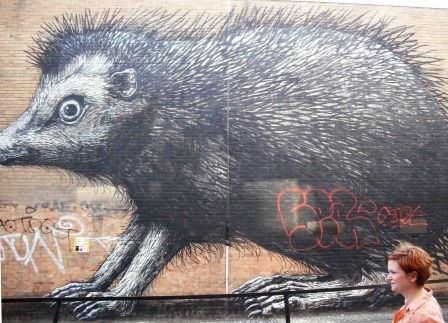
As mentioned in a previous post, Love Art London events like to end up in the pub — and fortunately I wasn’t disappointed. Just by chance I ended up chatting to Sabina in the Princess of Shoreditch and found that her interest in street art has led her to work on a PhD at University College London’s Bartlett School of Architecture. Her thesis has the neat title I’ve borrowed above: ‘This Is Not Graffiti’.
Sabina also introduced the intriguingly-named discipline of ‘geosemiotics’, which I subsequently couldn’t resist inserting into the novel. It means, if I understand properly, the study of meaning of words in a spatial context – so covers both ‘authorised’ signs and unsanctioned graffiti and Sabina’s work looks at the convergence of both – ‘hybrid surface inscriptions’. This may be, for example, where a street sign has been altered unofficially or the message of an advertisement subverted by the addition of extra text.
I found the subject fascinating from a fiction writing perspective – often the art is created out of letters or typography (as in Eine’s case) or, as with taggers, the signature has been stylised to the extent that the letters are often unrecognisable. What Sabina is investigating is an aspect of language that’s often taken for granted (the official public sign) and the conflicting motivations of those that try to undermine or subvert it – on a scale that stretches between principled protest and nihilistic egotism.
A couple of weeks later I visited Bristol, the home city of Banksy, who is synonymous with British street art but whose work we didn’t see in Shoreditch. W.H.Smith in Temple Meads station, featured a biography of Banksy (The Man Behind The Wall by Will Ellsworth-Jones in its bestseller section. Â Still intrigued by the Shoreditch tour I decided to buy the book and read it on the train on the way back.
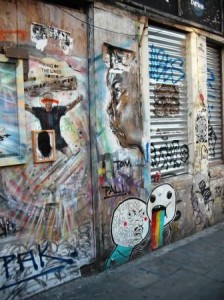
Banksy comes across in the book as similar in approach to Damien Hirst — the sort of figure who uses irony like a boomerang.  I was most interested in the stories of rivalry and disputes between the street artists were particularly entertaining. We’d seen some art on the Shoreditch tour that referred to King Robbo, an artist who’d been working around the area since the 80s and pre-dates Banksy.
As was reported on the Shoreditch tour, Robbo was badly injured last year (he was in a coma, although he’s recovering) and many of the other artists paid tribute to his work. It’s not clear from my photos as I didn’t get a complete view of the work originally but there’s a tribute to Robbo by (I believe) an artist called Don on a boarded up shop in Redchurch Street.
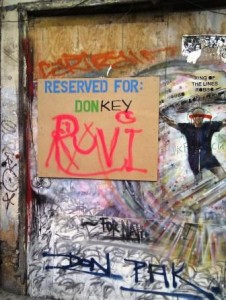
Around 2008, Robbo and Banksy were involved in an infamous dispute that apparently started when Banksy painted over a Robbo mural on the Regent’s Canal that had, surprisingly, survived intact for many years. There’s an intriguing account of how the mural was then adapted by Robbo and Banksy in turn to trade insults. Being in a relatively inaccessible section of the canal, Robbo had to put on a wetsuit and paddle on an inflatable raft to reach the wall, and falling in the water, which shows the lengths these artists are prepared to go to.
Sabina said that the Regent’s Canal was her favourite spot for street art so I was quite pleased that I have a little scene set on the towpath in my novel, probably very near the Robbo mural. And it seems quite appropriate that the canal is an unusually quiet, reflective place detached from the city — it’s almost at the boundary between urban and rural, one of the themes of the novel.
I drove into London at the weekend and came back via Shoreditch, Dalston and the Holloway Road. It was exactly the journey that’s made by some of my characters in the novel between two extremes of England. Despite having lived in Greater London for 16 years, through the graffiti tour I’ve gained a much better understanding of the urban view.

One Reply to “This Is Not Grafitti”